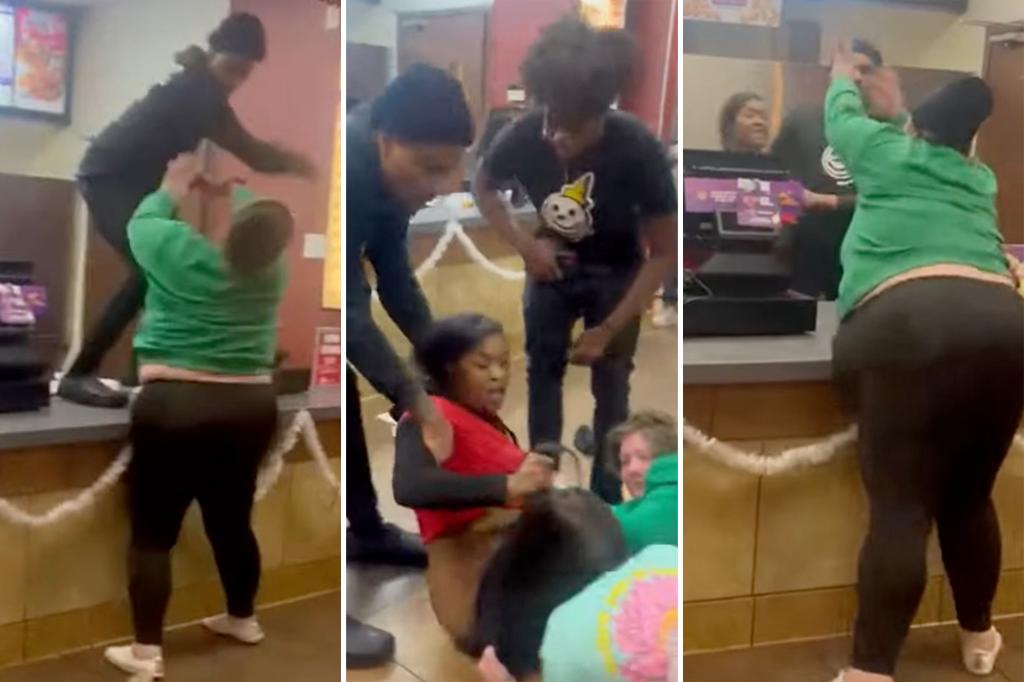The incident began with a seemingly trivial complaint over missing curly fries, but quickly escalated into a chaotic brawl. A woman, visibly agitated, approached the counter at a Jack in the Box restaurant, believed to be located in Spartanburg, South Carolina, and loudly berated the employees for omitting curly fries from her "three fing combos." Her frustration was palpable as she repeatedly demanded they rectify the situation, threatening to "blow this whole motherfer up" if her order wasn’t corrected. While the employees initially indicated their willingness to fulfill her request, the situation spiraled out of control when the woman began launching display signs from the counter at the kitchen staff.
This aggressive action served as the catalyst for the ensuing melee. The employees, no longer passive, responded to the projectile attack by advancing towards the woman. In a moment of bravado, the woman engaged in a taunting dance before attempting to strike one of the employees. She then escalated the confrontation further by picking up a metal object and throwing it at a worker, who narrowly avoided being hit. This act of aggression proved to be the breaking point. The worker retaliated by jumping onto the counter and delivering a forceful punch to the woman’s head, knocking her cap off and momentarily stunning her.
The initial punch ignited an all-out brawl. Employees surged over the counter, engaging in a flurry of punches directed at the woman. The situation further descended into chaos as an individual accompanying the woman joined the fray, resorting to hair-pulling. The scene was captured on video by bystanders, whose reactions ranged from jeering to expressions of concern and calls for police intervention. The chaotic nature of the brawl, with multiple individuals involved in physical altercations, made it difficult to discern the exact sequence of events. However, the video clearly depicted a rapidly escalating situation fueled by anger and frustration on both sides.
The video footage circulating on social media offered a visceral glimpse into the fast-food altercation. The woman’s initial complaint over missing fries seemed to quickly transform into an outburst of rage, characterized by verbal threats and physical aggression. Her actions, including throwing objects and attempting to strike employees, undoubtedly contributed to the escalation of the situation. However, the employees’ response, particularly the initial punch thrown by the worker, transformed the dispute from a verbal argument into a full-blown physical confrontation. The subsequent brawl, involving multiple employees and the woman’s companion, highlighted the volatile nature of the situation and the rapid deterioration of order within the restaurant.
The incident raises questions about conflict resolution and customer service in fast-food settings. While the woman’s behavior was undeniably aggressive and inappropriate, the employees’ response, though perhaps understandable in the heat of the moment, ultimately contributed to the escalation of the conflict. Ideally, de-escalation tactics could have been employed to address the customer’s complaint without resorting to violence. The incident also underscores the potential for seemingly minor disagreements to rapidly spiral out of control, particularly in high-stress environments like fast-food restaurants. The presence of bystanders recording the event further complicated the situation, potentially exacerbating tensions and influencing the behavior of those involved.
The aftermath of the brawl remained unclear based on the available information. It was unknown whether law enforcement became involved or if any arrests were made. The ultimate fate of the woman’s original complaint, the missing curly fries, was also left unresolved. The incident serves as a reminder of the importance of conflict resolution skills and the potential consequences of unchecked anger and aggression in everyday situations. It also highlights the challenges faced by fast-food workers who often deal with demanding customers and stressful working conditions. The video footage, while capturing a chaotic and disturbing event, provides an opportunity to examine the dynamics of customer-employee interactions and the need for effective de-escalation strategies in similar situations.










